Starting a lawn from grass seeds is easy, right? Simply, spread the grass seeds with a spreader for even coverage and water the lawn!
But will grass seeds thrown on the ground without being covered grow? The short answer is “yes”; grass seeds thrown on the ground will sprout, but there are myriad negative effects of planting grass seeds in this manner on the lawn.
Read on to find out why grass seeds and grass seedlings should be covered, what makes a good cover, and how to plant new grass seeds.
Will Grass Seed Grow If Not Covered?
If you desire a vibrant green, lush lawn, it’s important to follow the correct preparation techniques and sowing guides.
Learning these techniques will take time and effort, but the results are much more rewarding than simply scattering grass seeds on the soil.
There are a few steps you need to take before and after planting grass seeds, which are key to getting the grass to grow and flourish. The grass seeds will germinate but will diminish over time because they haven’t developed strong roots.
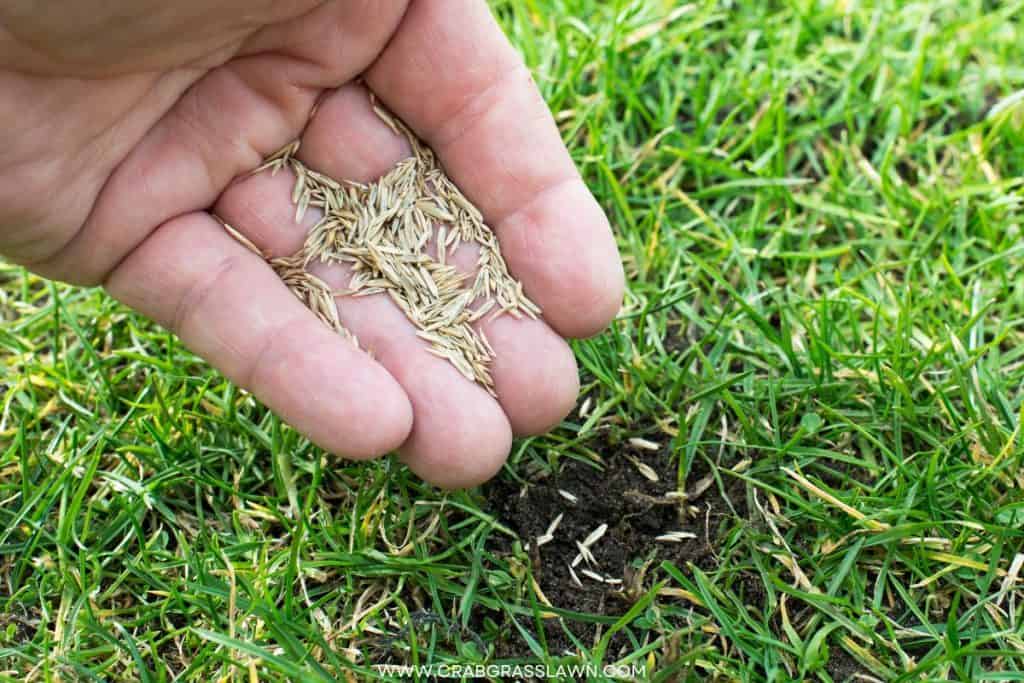
Why You Should Never Leave Grass Seed Uncovered
1. An Easy Food Target for Birds
Grass seeds are a favorite natural food for certain birds such as blackbirds, finches, sparrows, and starlings. Apart from covering grass seeds, there are several things you can do to prevent birds from eating grass seeds like using seeds that are coated with a bird repellant.
Adding to this, provide alternate bird food for birds by setting up bird feeders. Make sure to set up the bird feeders away from the lawn. You can also cover the seeds with a netting that lets light and water get to the seeds but doesn’t provide access to birds. This article provides great tips on where to set up your bird feeders.
2. Watch Out for Seeds Runoff
Planting grass seeds in certain weather conditions such as windy and rainy weather can cause the seeds to blow or wash away. There are plenty of ways to prevent seed runoff, but using straw and erosion-control netting are the two most effective.
The Geotextile erosion netting is a non-woven needle-punched fabric that provides high water flow and prevents erosion. It is both mildew and rot-resistant and is quick and easy to install.
- HEAVY DUTY – 8 Ounce Heavy Duty Geotextile – Don’t settle for lighter weights, the 8 ounce is tough and durable, non-woven fabrics are produced to be high-strength
- EASY TO INSTALL – Save time and money, we stock many sizes to cut down on scrap, one single piece cut to exact dimensions
- MADE TO LAST – Will last many years and stands up to the toughest conditions, Superior strength, dimensionally stable, UV/rot resistant
Affiliate links and images pulled from the Amazon Product Advertising API on: 2025-07-07
This heavy 8-ounce erosion netting can be used for landscaping, retaining walls, and French drains. pond underlayment and construction projects.
3. Your New Seeds May Dry Out
Grass seeds need to be placed in moist conditions to sprout. Even if you provide adequate water, the grass seed will dry out if the temperature is hot and dry. Grass seed covers such as mulch or topsoil retain moisture, which prevents grass seeds from drying out.
4. Germination May Be Challenging
As mentioned above, grass seeds will grow if not covered with a layer of straw or a layer of topsoil, but all the seeds may not germinate. Therefore, you will be wasting effort and cash. Learn about the effects of temperature and water on new grass seeds.
5. Grass Quality May Be Impacted
Grass seeds that aren’t covered with straw mulch, pine straw, or additional topsoil will not develop strong roots, which can affect the quality of the grass.
Grass seeds will only grow deep and healthy root systems if they are left undisturbed, therefore it is important to protect the seeds with a thin layer of soil or straw until the roots establish
5 Best Mulch Options to Cover Grass Seed With
When looking for the best mulch options to cover grass seed with, you’ve got several products to choose from. Here are my top 5 picks.
1. Peat Moss
Peat moss offers many uses when used as a soil amendment such as helping your lawn’s aeration and drainage and increasing moisture retention.
Covering grass seeds with peat moss provides twofold benefits – protects the seeds from being washed or carried away and prevents the seeds from drying out and adds beneficial nutrients to the soil.
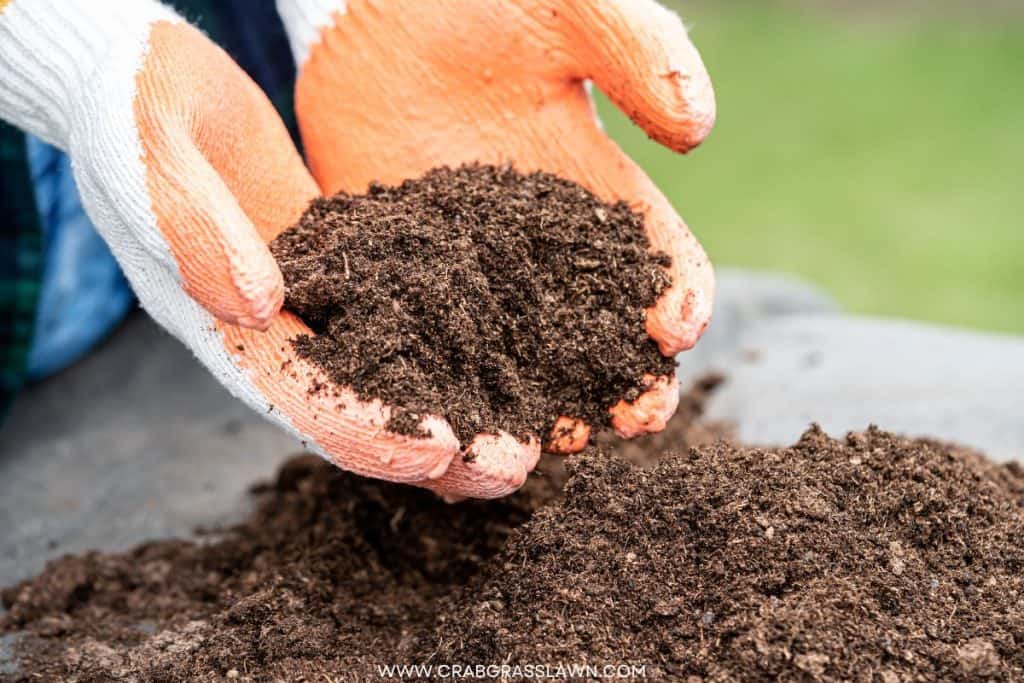
2. Sawdust
Sawdust is a good alternative to straw for covering grass seeds for good growth. However, unlike fertilizers, sawdust is a less valuable soil addition, but on a brighter note gets the job done. Did you know that sawdust is prone to compaction so avoid using it as compost?
- Adding a sawdust cover over grass seeds is easy
- Start by loading a wheelbarrow with a bag of sawdust
- Add roughly 3 lbs of grass seeds
- Mix with a shovel and water heavily to soak
- Cover with a tarp and let the seeds germinate for 5 days
- Mix 3 shovels of germinated grass seed/sawdust mixture with 1/2 wheelbarrow of topsoil
- Spread this final mixture across your lawn
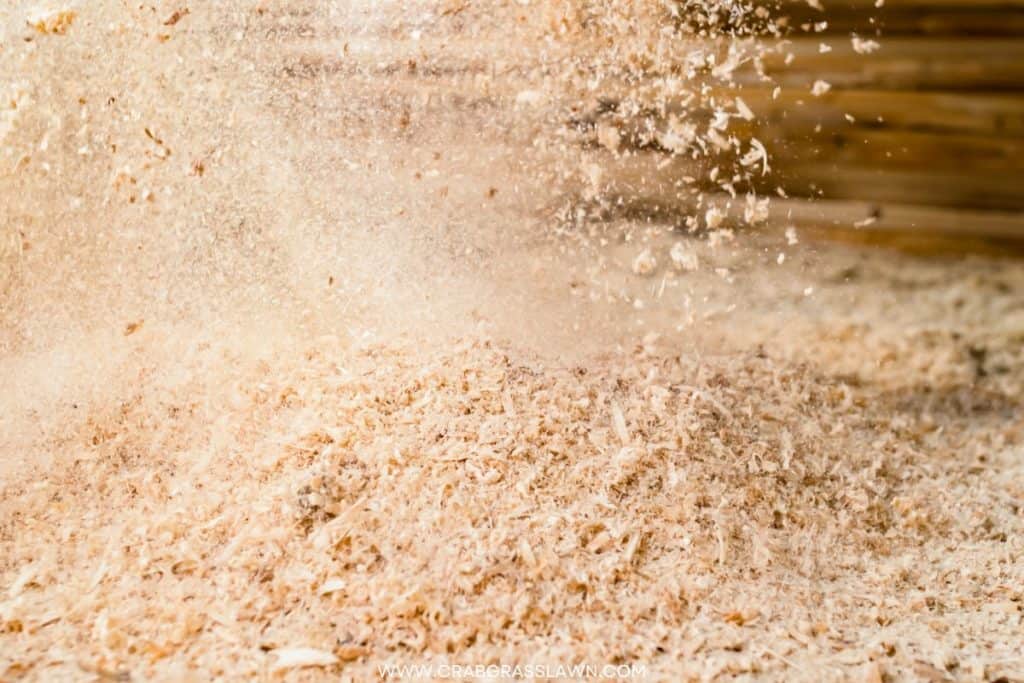
3. Paper Mulch
There are two major types of mulches – organic and inorganic mulches. Organic mulches include bark, wood chips, pine needles, pine straw, and chopped leaves.
Inorganic mulches include materials such as newspapers, pebbles, landscape fabrics, and recycled rubbers. You can make paper mulch, aka green mulch out of shredded paper.
Paper mulch is somewhat organic since paper comes from trees, but is billed as inorganic due to the toxins in the ink printed on the paper.
Watch this video to learn how to make paper mulch:
4. Grass Clippings
Grass clippings from lawnmowers can be used to cover grass seeds for quick germination rates. First, collect the leaves from the mower bag or with a leaf rake, and set them to dry completely. Wet leaves can attract mold.
Spread the grass clippings evenly and lightly over the grass seeds to provide a good layer of protection. The clippings will break down over time and add nutrients to the soil.
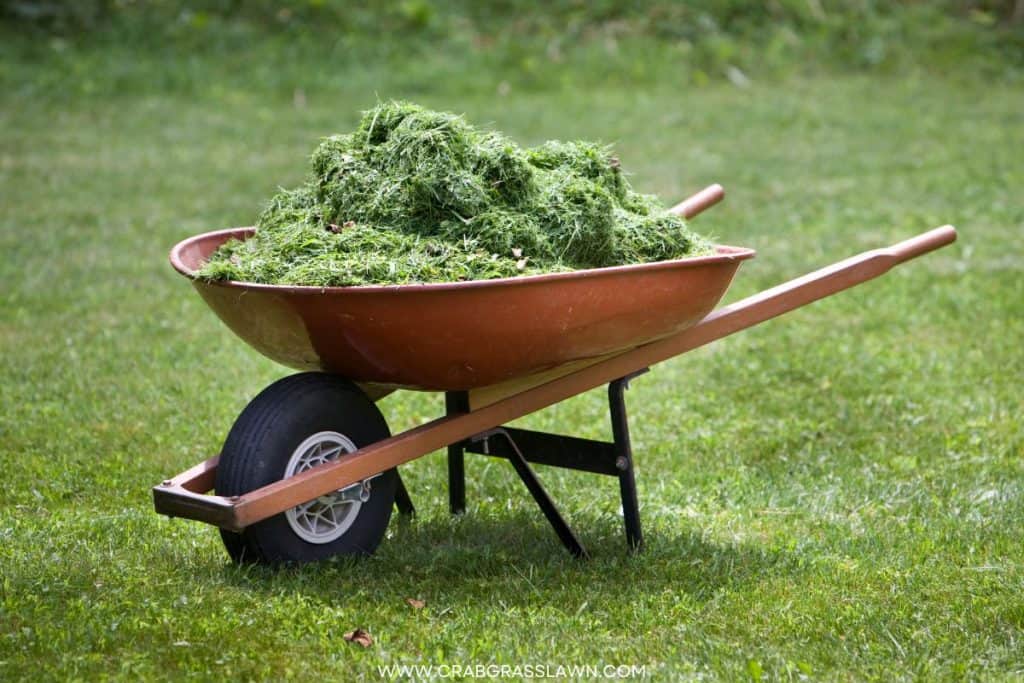
5. Plastic Sheeting
You can cover new grass seeds with plastic sheeting, like the ones sold in rolls at your local home improvement store. Make sure the plastic is completely transparent because light needs to fully reach the grass seeds for them to germinate and grow.
Clear plastic sheeting protects grass seeds and holds in moisture. However, it’s important to remove the plastic covering as soon as you notice proper growth from the grass seeds.
How to Plant the New Grass Seeds?
1. Spend On Some Quality Seeds
When buying grass seeds, remember that you get what you pay for. High-quality seeds will have better germination rates and will be more free of weed seeds and other crop seeds.
Adding to this, pay attention to the percentage of other crop seeds listed on the grass seed manufacturer label.
For example, a bag of tall fescue grass seed can contain other crop seeds such as Kentucky bluegrass or rough bluegrass, which is considered a weed in Kansas, therefore it’s listed as “a percentage of other crop seed”.
When looking at the grass seed manufacturer label, check out the percentage of weed seed. High-quality grass seeds will have 0 percent weed seeds and will cost more than grass seeds with weed seeds.
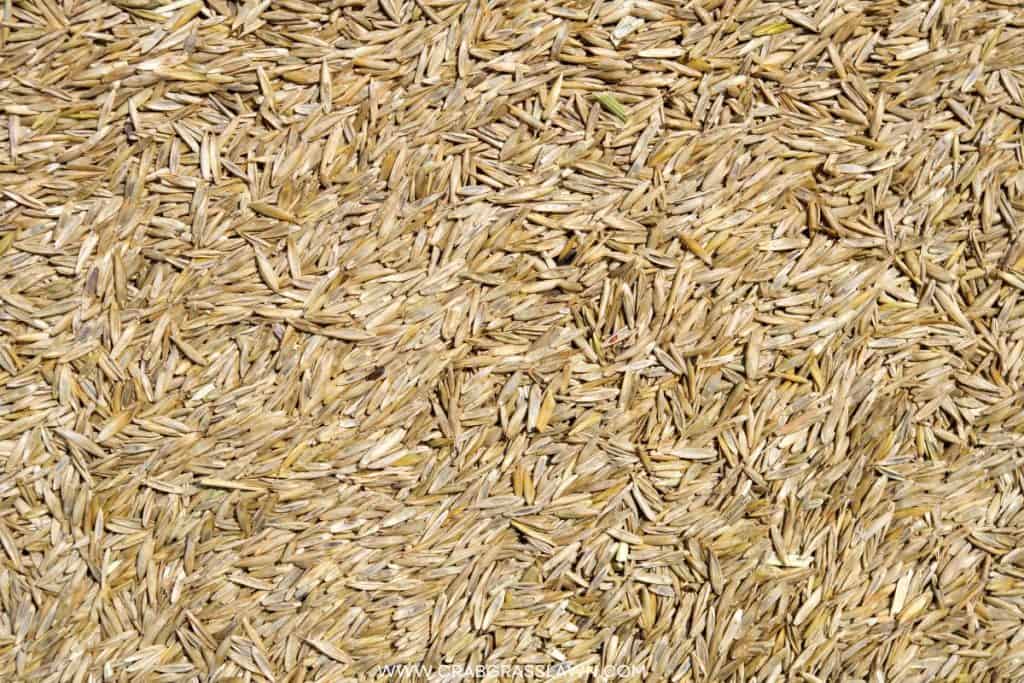
2. Prepare the Soil
Well-prepared soil is the stepping stone to a beautiful lawn. The soil surface should be cleared of any debris, dead existing grass, and weeds.
No soil is perfect and the only way to gauge the imperfections in your soil is with a soil test. Grass seeds germinate and grow best in soil that has a pH between 6.0 and 7.5.
The soil pH test results will tell you whether you have acidic soil or alkaline soil. A pH test also reveals the nutrients that are missing from the soil.
You can perform a soil test at home without a soil test kit by using vinegar and baking soda. Even though the results from this method won’t be as accurate as a soil test kit, it will give you a good idea of what your soil is lacking.
After checking your soil pH and adding the appropriate fertilizer such as starter fertilizer, natural fertilizer, or pre-seeding fertilizer for strong root growth, use a rotary tiller to break up compacted soil and create loose soil.
Next, spray the area with water to keep grass seed moist and add in some nutrients and organic matter like compost, yard waste, or a slow-release fertilizer.
3. Spread Your Seeds
The best time to spread grass seeds is during the respective seed’s natural period of active growth. So, the “when” to plant grass seed depends on the type of seed you choose.
Cool-season grass seeds such as Kentucky bluegrass and fescue do well when it’s a bit cooler, whereas warm-season grasses such as Bermudagrass and Bahai grass do best in warmer temperatures of late spring to early summer.
You can spread grass seeds with your hands but the pros use a lawn spreader with the right spreader settings for even coverage.
Germinating grass seeds is one of the slower parts of the seeding process. Certain types of grass such as bentgrass and bluegrass are notorious for being slow to germinate.
To accelerate the germination process:
- Soak the seeds in tubs or buckets for 24 hours
- After this period, drain the water completely by pouring the seeds through a sieve
- Once drained, place the seeds in a warm location such as a heated shed or garage
- Stir the seed around once or twice a day for two days to ensure even moisture distribution
- Check the seeds after 3 days to see if they are ready – white shoots should appear
- At this stage, the seeds are ready to plant
- Before casting grass seeds, water the area to kick start the germination process
4. It’s Time to Cover the Seeds
Spread a light layer of mulch such as sawdust, shredded paper, or light peat moss over the entire seeded area.
5. Water Generously
Watering your new grass seed generously doesn’t mean throwing a ton of water on it, as doing so can wash away the seeds.
There are a few factors to consider when deciding how much to water new grass seeds including shade and excessive sunlight.
A thumb rule is to keep the top inch of soil moist at all times, which generally requires 2 – 6 minutes of watering each day (depending on the weather).
6. Treat Your Grass With Care and Avoid Heavy Traffic
After planting grass seeds, avoid walking on your lawn for at least 4 weeks. You should be able to walk on your newly seeded lawn in 6 – 8 weeks after planting grass seeds.
How to Grow Grass Seed if Not Covered
You can use a spreader to spread grass seeds if you don’t want to apply a cover. However, it’s beneficial to add a layer of mulch over the seeds to keep them moist and help with germination.
Water your lawn before and after spreading grass seeds, and ensure that the top one inch of soil is moist at all times.
FAQs
Q. How Long Does It Take for Grass Seeds to Germinate?
A. Most grass seeds germinate within 10 – 14 days but can take longer up to 30 days depending on the type of grass seed and growing conditions.
Q. Should I Soak Grass Seeds Before Planting?
A. You can soak grass seeds for 3 – 5 days in water to speed up the germination process. Some types of grass seeds like Kentucky bluegrass should be soaked for 5 days.
Q. What Month Is Best to Put Grass Seed Down?
A. The best time to plant grass seeds varies between cool-season and warm-season grass. Cool-season grasses should be planted in early fall or around September and warm-season grasses in late spring or early summer.
Q. What to Do if Grass Seed Doesn’t Grow
A. If grass seeds don’t grow, check if they are buried too deep or sitting on the surface. Further, ensure that the grass seeds are receiving the right amount of sunlight and water.
Here’s an informative video discussing whether you can grow grass without covering the seed:
Final Thoughts
Grass seeds will grow if not covered but will probably not result in healthy grass growth. Covering grass seeds makes them less likely to wash away or blow away in windy conditions.
There are several types of cover for grass seeds such as paper mulch, plastic sheeting, and light peat moss.
Before spreading grass seeds, give your lawn a good watering and repeat this step after casting grass seeds.
Hi, Alex Kuritz here. Growing up I remember that my family had one of the best lawns in the neighborhood. Richly green and lush. I did a lot as I grew up in terms of caring and tending for not only my family’s lawn but also my neighbors. I can say I have years of experience, and I am here to share it with you.



